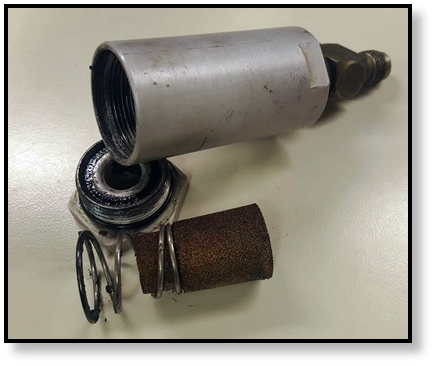In the world of compact equipment, even the most seemingly minor component can make or break your machine’s performance. One such part, frequently overlooked but absolutely essential, is the case drain filter. It is a low-profile workhorse hidden in your hydraulic system, and when neglected, it can lead to catastrophic damage to your final drive motor.

At Texas Final Drive, we’ve seen the aftermath of ignored or clogged case drain filters: cracked housings, shredded rotator groups, and thousands of dollars in repairs. Here’s what every equipment owner and operator needs to know about this vital component.
Here are a few Shop Talk blog posts you might be interested in:
- Identifying the Hydraulic Ports on a Final Drive Motor
- Bobcat Final Drive Failures and Case Drain Filters
- Preventing Case Drain Related Failure on Final Drive Motors
What Does the Case Drain Line Do?
Let’s start with the basics. Inside your final drive motor, particularly if it’s a piston-type motor, some hydraulic fluid naturally leaks from the rotating group during operation. This leakage isn’t a defect—it’s actually necessary for lubricating the piston shoes, swash plate (or thrust plate), valve plate, and other internal parts.
But that leaked fluid must go somewhere. That’s where the case drain line comes in. It routes this low-pressure fluid back to the hydraulic tank.
If your machine has a case drain line, it almost certainly has a case drain filter, and many of final drive motors we work on do.
The Job of the Case Drain Filter
The case drain filter is an in-line filter placed along the return path to the hydraulic reservoir. Its job is to catch contaminants before they spread to the rest of the system. That includes internal debris (metal shavings, rubber fragments) and fine particulates generated from component wear.
A typical case drain filter is housed in a small aluminum canister with a sintered bronze element inside. This filter medium is made by compressing and fusing tiny bronze spheres, forming a durable, porous barrier that traps particles as small as 40 microns—about the limit of what the human eye can detect.
When new, the filter appears bronze or golden. But once clogged, it turns dark and risks becoming a ticking time bomb.

What Can Happen When the Filter Gets Clogged
A clogged case drain filter can spell disaster. Here’s a breakdown of what happens and why it matters:
- Unrelieved Pressure Build-Up: The case drain line is meant to handle fluid at low pressure. If the filter clogs, pressure builds up because the fluid has nowhere to go, and unlike other parts of the hydraulic system, most case drain circuits don’t have a relief or bypass valve.
- Seal Failure: That rising pressure can rupture the oil seal between the planetary hub and the hydraulic motor. This causes hydraulic oil to flood into the gear hub and allows dirt, grit, and metal fragments to flow the other direction.
- Rotator Group Destruction: The piston shoes can blow out of place, the barrel may shatter, and the valve plate can sustain major scoring. You could be left with a completely wrecked rotator group.
- Bearing and Cam Ring Damage: In both axial and radial piston motors, the excessive pressure can cause bearings to fail and cam rings to crack or deform. In radial piston motors, pistons may lift off the cam entirely, only to hammer back down with destructive force.
- Cover Plate Failure: In extreme cases, the pressure can cause the cover plate to warp, crack, or even blow off entirely. This poses a serious risk to any technician working nearby.
- Contamination Spread: If seals rupture, outside contaminants like water, dust, and sand infiltrate the system. Meanwhile, internal debris circulates unchecked. This creates a slurry of sludge that destroys everything it touches, and cleaning it out requires a complete system flush, new filters, and a new final drive motor.

How to Prevent Case Drain Filter Failure
The good news is that all this damage is preventable with simple maintenance:
- Replace regularly: Follow your manufacturer’s recommended service intervals. A good rule of thumb is to replace the case drain filter every time you change the other hydraulic filters.
- Don’t clean—replace: Trying to clean a sintered bronze element usually does more harm than good. Brushing or blasting it can embed particles deeper, making the filter even more restrictive.
- Work clean: Anytime you service the hydraulic system, take care to avoid introducing dirt or letting fluid escape from open lines. Plug hoses, cap ports, and clean fittings before reassembly.
One Small Part. One Big Responsibility.
Inexpensive. Easy to change. Crucial to your machine’s health.
The case drain filter doesn’t look like much, but it plays a critical role in preventing pressure spikes, fluid contamination, and mechanical failures. If you’re troubleshooting a weak or noisy final drive—or planning your next hydraulic service—don’t forget this essential component.
At Texas Final Drive, we’re here to help you keep your machine running strong. Whether you’re a contractor fixing equipment yourself or managing a full fleet, we’re here for you. Whether you need a new case drain filter or a replacement drive, we can help keep you on track.


